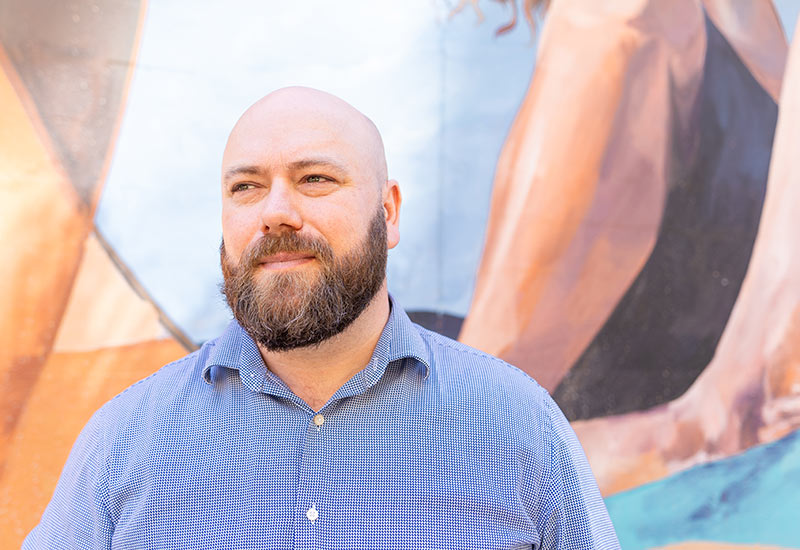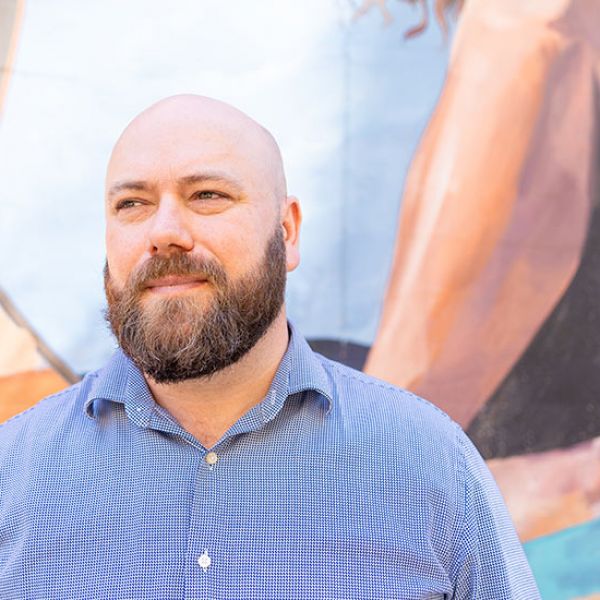Advancing access to justice and legal reform
Dr Ray Nickson
After beginning his career as a legal aid lawyer, Dr Ray Nickson continues his passion for supporting underserved communities through research. To achieve this, he collaborates with community and industry partners to promote access to justice.

“It’s no great revelation that some people can’t access the legal help that they need,” Ray explains. “We also observe barriers to people ensuring their legal rights are upheld.”
These challenges are most pronounced for people already marginalised and disadvantaged. In this way, much of his research serves the same communities he served as a lawyer.
Ray is currently collaborating with the criminal law divisions of legal aid offices across Australia. This research has enhanced our understanding of the challenges lawyers face in providing access to justice for groups already disadvantaged in the legal system.
An important outcome of this research so far has been the identification of legal first responders.
“Legal first responders provide legal assistance at times of immediate need, usually during some sort of legal emergency”, Ray notes. Legal first response is a role mainly performed by duty lawyers.
“For a victim of domestic violence seeking protection from their abuser, any delay in providing legal assistance can put that person at further risk,” Ray explains. “Similarly, if you have a cognitive impairment or a mental health condition, delay in receiving legal assistance can compound your disadvantage in the legal system.”
The toll of legal work
Ray has interviewed duty lawyers in metropolitan, regional and rural locations throughout Australia. Duty lawyers help people appearing in court that day, including people in custody who require assistance with bail.
The personal and professional toll of legal work is another dimension of Ray’s research.
“We want to ensure that people are healthy and well in their work. Lawyers working in these roles are a community resource, especially for marginalised groups. Every time someone burns out that’s a loss of expertise and experience in providing access to justice.”
An unexpected finding from that research was the impact judicial bullying had on many lawyers. Judicial bullying is when a judge or magistrate bullies a lawyer or other professional in the courtroom.
Ray’s article on judicial bullying gained immediate attention. The issue has always been taboo, and very little had previously been written about it.
“I could recall witnessing that type of behaviour in courts when I was practising, but really didn’t think it would still be an issue. It was appalling some of the stories very new lawyers shared about their experiences of bullying.”
Improving the court experience for victims
The Department of Communities and Justice is another research collaborator. Ray is undertaking an evaluation of recent training for people working in the Specialist Family Violence List Court pilot.
“The specialist list in local courts is an important initiative in improving the court experience for victims of family violence,” Ray explains.
“A key goal is to better coordinate and integrate courts, lawyers and service providers to meet the needs of victims and offenders. Our research works to identify how this coordination and integration can be optimised.”
Access to justice is not only about increasing access to lawyers and courts. He also researches how alternatives to adversarial legal processes can improve people’s interactions with the legal system and resolve conflict.
Literacy and legal confidence
Ray has been working with Literacy for Life to increase our understanding of literacy’s role in how people experience the legal system. Literacy for Life is an Aboriginal-led charity delivering mass literacy campaigns to communities across Australia.
Ray’s involvement with Literacy for Life began almost ten years ago when he spent lengthy periods working with community members and service providers in Bourke and Enngonia. Those conversations revealed how improving literacy transformed people’s experience of the justice system.
“It was as simple as obtaining a driver's license,” he notes.
“People didn’t have the reading skills to get their driver's license, and this would escalate over subsequent encounters with police and courts to significant penalties, including time in custody. This was one path into the legal system that literacy could reduce, among many.”
Literacy for Life has recently expanded its operations to pilot its literacy campaign in custodial settings. Ray was asked to evaluate the first iteration of this campaign for Aboriginal inmates at Long Bay Correctional Complex.
“I consider it a privilege to be asked to contribute to this important work. Literacy for Life achieves educational outcomes that we have failed to achieve as a society. Literacy is a fundamental right for everyone, and improving literacy has enormous ramifications for how people can access justice.”
A restorative justice focus
Ray’s work has had a large restorative focus, too.
“This was a result of my PhD experience. I was analysing what impact war crimes trials of senior leaders had on communities transitioning from conflict. Much of what was successful reflected the values of restorative justice.”
Transitional justice describes the ways in which communities transitioning from conflict to peace and authoritarianism to democracy respond to the legacies and experiences of violence and oppression.
Transitional justice has been a subject of research and practical focus for Ray, who worked with legal teams at the International Criminal Tribunal for the Former Yugoslavia, drawing on his experience in criminal law in South Australia.
His research in transitional justice took him to The Netherlands, Bosnia, Croatia, Serbia, and Cambodia.
Speaking with people in the communities affected by conflict in those countries highlighted how responses beyond courtrooms were often the most impactful. It was restorative practices in these settings that usually had transformative power.
Restorative justice across continents
This led Ray to work with tribal nations in the Pacific Northwest to examine their restorative justice initiatives.
“For the tribes I worked with, restoration had multiple layers of meaning,” Ray shares.
“These were tribes who had their sovereign status terminated and who fought over decades to have their sovereignty restored. Adopting restorative justice practice in their tribal courts, informed by their culture, was an assertion of that sovereignty and a more successful response to harms and conflict.”
That work encouraged him to develop the concept of ‘restorative spaces’.
A restorative space allows an encounter between groups who are in or have been in, some form of conflict. A typical example is a memorial or museum that seeks to educate visitors about the past, particularly where violence and oppression by one group over another has occurred.
“These spaces should be driven by the communities they discuss and provide an opportunity to be heard and share their stories.”
Personal loss, powerful advocacy
Ray has also been advocating for the adoption of restorative justice in response to adverse medical events. This is the result of Ray’s own experience with his daughter, Edna.
“Edna was the victim of an adverse medical event that eventually contributed to her passing. We were encouraged to sue but couldn’t face the pain that a legal process would have compounded for us.”
While other medical professionals advised his family to sue, the hospital undertook its own investigation.
“We were advised that the surgeon had been dismissed, but we had no visibility of the process. There was no transparency, and we were concerned that no lessons would be learned so that health care providers could grow from this experience and future patients would be better protected.”
Ray, with Dr Alice Neikirk, advocated that a restorative practice would have better responded to the harms that flowed from this event.
“We need to replace stigma and blame with healing and learning,” Ray notes.
“When there’s an adverse medical event, we want to restore healthcare relationships whenever possible and respond in ways that promote the wellbeing of patients and their families.”
Ray has been teaching restorative justice at the undergraduate and postgraduate levels for a decade.
“There’s a lot of misunderstanding about restorative justice, even with our law students. Teaching restorative justice is a great opportunity for the entire class to challenge our own assumptions about law and justice.”
Access to justice in the classroom
Teaching at the tertiary level has been another way Ray has sought to serve others and promote access to justice.
“I started teaching at universities in 2007. One of my first roles was to run the law pathways course at Flinders University,” Ray recalls.
The pathways course was an opportunity for non-traditional students to enter university. Most of Ray’s students were refugees who had recently arrived in Australia and were seeking to enter university.
He spent many years teaching criminology and chairing a criminology department in the United States.
“I had the privilege of working in a wonderfully diverse community. We were a Hispanic serving institution, and the students were amazing.”
Ray helped many students, most who were the first in their families to attend university and many from non-English speaking backgrounds, go on to law schools.
“I’m still in touch with the graduates all the time. I love hearing about their achievements, great and small.”
Fusing a love for research and sports
During that period Ray was able to cultivate his love of sports into a service role at the university, first as faculty representative for the baseball team and then as the NCAA Division II academic compliance officer.
“I used to have my office hours in the stands during baseball practice – it was a lot of fun to meet with the students that way.”
Ray has even been able to fuse his love of sports with research as the leading expert on baseball’s history in Australia, publishing multiple articles on the topic. He continues to write about sports history, baseball and beyond.
His current project examines the role of migrants from Asia in advancing baseball during the early years of the White Australia policy.
He’s regularly invited to speak nationally and internationally on sports history and is a member of the Australian Society for Sports History and the Society for American Baseball Research.
The University of Newcastle acknowledges the traditional custodians of the lands within our footprint areas: Awabakal, Darkinjung, Biripai, Worimi, Wonnarua, and Eora Nations. We also pay respect to the wisdom of our Elders past and present.
